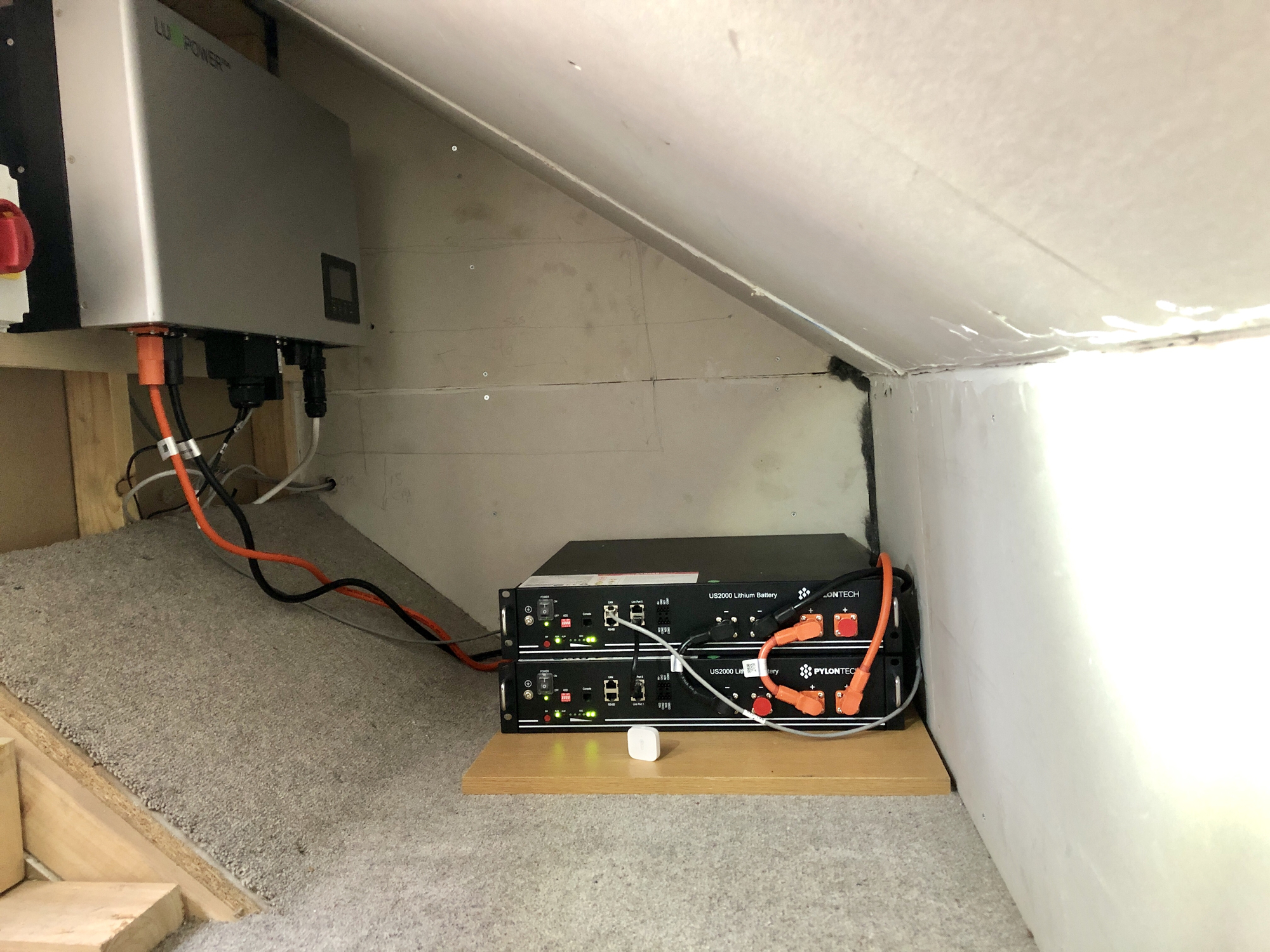We’d like to remind Forumites to please avoid political debate on the Forum.
This is to keep it a safe and useful space for MoneySaving discussions. Threads that are – or become – political in nature may be removed in line with the Forum’s rules. Thank you for your understanding.
📨 Have you signed up to the Forum's new Email Digest yet? Get a selection of trending threads sent straight to your inbox daily, weekly or monthly!
On-grid domestic battery storage
Comments
-
I know you all like install photos.
Sadly, nothing much to show here. Its up a storage area in the loft space. Cabling back down the consumer unit via external conduit.
No racks, no need. No one will be going in there. Enough space to add a few more batteries later down the line.
Little white thing at the front is a Xaomi temperature sensor linked to Home Assistant to measure ambient temps in there.
Although Jake at Infinity says there is little worry about temperature wise. If they can last in an Australian summer they should be fine in Sheffield.

17 x 300W panels (5.1kW) on a 3.68kW SolarEdge system in Sunny Sheffield.
12kW Pylontech battery storage system with Lux AC controller
Creator of the Energy Stats UK website and @energystatsuk Twitter Feed4 -
I still really really want battery storage especially after receiving daily updates of this thread and seeing all the fun geekery all you guys experience. But based on above post, it still makes absolutely no financial sense...chamelion said:I've visited and revisited battery storage probably every 6 months or so and each time get put off by the math. Doing a seriously quick back of the envelope calculation here's a scenario:
7.2kwh install for £3500 = 6.5kwh usable based on DoD.
Optimistic outcome:- I charge it 100% through my PV array, so cost to charge = 0
- I use it exclusively during my agile octopus peak when it's let's say 22p/kwh. For sake of this optimistic math, I use up the full 6.5kwh in this period during electric peak.
- So my electric saving is £1.43/day
- break even point = 6.7 years
- Charge blended through PV and cheap overnight rates of 5p blended through the year (over winter won't generate enough to charge fully). Let's call it 50-50, that's 18p a day to charge after assumed round trip losses
- Cost savings based on my average per kwh price rate from agile. This week was 6.22p/kwh based on daily usage. Savings here for a full cycle then would be 40.4p.
- So, savings here is 40.4p - 18p = 22.4p per day, or 81 quid a year.
- break even point = 43 years, and this assumes no maintenance cost / inverter replacements etc.
5.41 kWp System, E-W. Installed Nov 2017
Lux + 3 x US2000B + 2 x US3000C battery storage. Installed Mar 2020.0 -
Looks nice and tidy. You may want to consider some spacing between the batteries as specified in the manual.Zarch said:I know you all like install photos.
Sadly, nothing much to show here. Its up a storage area in the loft space. Cabling back down the consumer unit via external conduit.
No racks, no need. No one will be going in there. Enough space to add a few more batteries later down the line.
Little white thing at the front is a Xaomi temperature sensor linked to Home Assistant to measure ambient temps in there.
Although Jake at Infinity says there is little worry about temperature wise. If they can last in an Australian summer they should be fine in Sheffield.

Warning re. temperature, if the temperature goes below zero, the batteries switch themselves off.
Mine was originally in the loft (not as nice as the one above), and they shut down a lot over winter.
Only issue now there in the house, is the sofar comms card drops as its always done - a restart fixes it, but can't do remotely of course.0 -
Lol, i was entirely clear.... it was you who was worried.joefizz said:Solarchaser said:
The manual assumes using brackets does it?
So does it also assume you cannot put them in a rack without those brackets?
Technical manuals do not assume!
My manual mentions nothing about distance from the inverter, what version do you have?
If its saying 500mm in yours, then my 450mm plus 18mm of insulation in the form of the mdf shelf will be more than enough.Hope that clears things up for you.
I hope you have cleared it up for yourself😜West central Scotland
4kw sse since 2014 and 6.6kw wsw / ene split since 2019
24kwh leaf, 75Kwh Tesla and Lux 3600 with 60Kwh storage0 -
That's pretty much the same as mine, only in a cupboard under the stairs. Stays at a pretty steady 15-17°C so likewise not worried about temps.Zarch said:I know you all like install photos.
Sadly, nothing much to show here. Its up a storage area in the loft space. Cabling back down the consumer unit via external conduit.
No racks, no need. No one will be going in there. Enough space to add a few more batteries later down the line.
Little white thing at the front is a Xaomi temperature sensor linked to Home Assistant to measure ambient temps in there.
Although Jake at Infinity says there is little worry about temperature wise. If they can last in an Australian summer they should be fine in Sheffield.

I notice, like yours, some don't have the ground cables fitted. Is there a situation where they're not required ?Scott in Fife, 2.9kwp pv SSW facing, 2.7kw Fronius inverter installed Jan 2012 - 14.3kwh Seplos Mason battery storage with Lux ac controller - Renault Zoe 40kwh, Corsa-e 50kwh, Zappi EV charger and Octopus Go0 -
chamelion said:
really depends on your usage of electricity - I have 2 NAS drives that use 550W 24x7, so for me with 3kw solar panels and 9.6kWh batteries made sense for the best summer we had in 2018, running the house without any import for nearly 2 months continuous. In winter of course, the saving in nearly zero.
I still really really want battery storage especially after receiving daily updates of this thread and seeing all the fun geekery all you guys experience. But based on above post, it still makes absolutely no financial sense...
I'll see if I can dig out my calculator.
I'm a geek btw, so tech brain probably got in the way of economics too :-)
If you have no real load, then you're right.0 -
Can the zappi not be set with a minimum export threshold?EVandPV said:
You could be right, the Lux and Zappi both use 2 CTs so that's 5 including the arduino.joefizz said:
I dont know the Lux at all so take this with a pinch of salt but....
Im not a big fan of multiple CT clamps as theres just too much room for error and feedback loops
It's a bit Heath Robinson with bits of code from various sources and I'm not sure if it's worth the bother trying to resolve the conflict.
I'll probably end up removing it and just use the 'boost' button on the immersion timer when the batteries are full.
I must admit ive looked at quite a few of the diverters, so i may be getting mixed up, but i thought you could set the zappi to not power up the immersion below a set amount of threshold, say 300w so that the lux always takes the excess, and the zappi only kicks in when lux is full?West central Scotland
4kw sse since 2014 and 6.6kw wsw / ene split since 2019
24kwh leaf, 75Kwh Tesla and Lux 3600 with 60Kwh storage0 -
It's not actually the zappi causing the problem. I haven't been using it in eco+ mode yet as we're not getting enough surplus pv.Solarchaser said:
Can the zappi not be set with a minimum export threshold?EVandPV said:
You could be right, the Lux and Zappi both use 2 CTs so that's 5 including the arduino.joefizz said:
I dont know the Lux at all so take this with a pinch of salt but....
Im not a big fan of multiple CT clamps as theres just too much room for error and feedback loops
It's a bit Heath Robinson with bits of code from various sources and I'm not sure if it's worth the bother trying to resolve the conflict.
I'll probably end up removing it and just use the 'boost' button on the immersion timer when the batteries are full.
I must admit ive looked at quite a few of the diverters, so i may be getting mixed up, but i thought you could set the zappi to not power up the immersion below a set amount of threshold, say 300w so that the lux always takes the excess, and the zappi only kicks in when lux is full?
The problem is that when the Lux is active, it skews the readings the arduino recieves from the ct. When the Lux is in standby, the arduino ct reads correctly.
No idea why as the zappi ct's aren't affected the same way.
I have a possible solution though. I use a light dependant resistor hooked up to the arduino to read the flashing led on our pv meter and calculate pv generation. We have a smart meter now for our leccy which also has a flashing led. If I can work out how to attach another LDR to the arduino, I should be able to use that instead of the ct clamp.Scott in Fife, 2.9kwp pv SSW facing, 2.7kw Fronius inverter installed Jan 2012 - 14.3kwh Seplos Mason battery storage with Lux ac controller - Renault Zoe 40kwh, Corsa-e 50kwh, Zappi EV charger and Octopus Go0 -
Ahh ok, i thought you were using the zappi immersion diverter, harvi maybe?
But now i see you said you were using your arduino.West central Scotland
4kw sse since 2014 and 6.6kw wsw / ene split since 2019
24kwh leaf, 75Kwh Tesla and Lux 3600 with 60Kwh storage0 -
Yeah, your thinking of the Eddi. The Harvi gives the zappi wireless ct transmission when you need more than 2 ct's as it only supports 2 wired ct's. I've got one ct on the grid wire and one on the Lux so that the zappi doesn't drain the batteries.Solarchaser said:Ahh ok, i thought you were using the zappi immersion diverter, harvi maybe?
But now i see you said you were using your arduino.
Scott in Fife, 2.9kwp pv SSW facing, 2.7kw Fronius inverter installed Jan 2012 - 14.3kwh Seplos Mason battery storage with Lux ac controller - Renault Zoe 40kwh, Corsa-e 50kwh, Zappi EV charger and Octopus Go1
Confirm your email address to Create Threads and Reply

Categories
- All Categories
- 352.4K Banking & Borrowing
- 253.7K Reduce Debt & Boost Income
- 454.4K Spending & Discounts
- 245.5K Work, Benefits & Business
- 601.3K Mortgages, Homes & Bills
- 177.6K Life & Family
- 259.4K Travel & Transport
- 1.5M Hobbies & Leisure
- 16K Discuss & Feedback
- 37.7K Read-Only Boards



